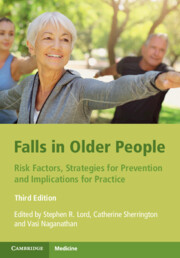Part I - Epidemiology and Risk Factors for Falls
Published online by Cambridge University Press: 04 November 2021
Summary

- Type
- Chapter
- Information
- Falls in Older PeopleRisk Factors, Strategies for Prevention and Implications for Practice, pp. 1 - 248Publisher: Cambridge University PressPrint publication year: 2021



